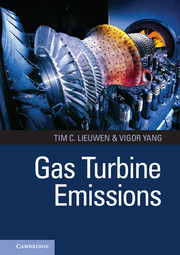Book contents
- Frontmatter
- Contents
- List of Contributors
- Foreword
- Preface
- Part 1 Overview and Key Issues
- 1 Aero Gas Turbine Combustion
- 2 Ground-Based Gas Turbine Combustion
- 3 Overview of Worldwide Aircraft Regulatory Framework
- 4 Overview of Worldwide Ground-Based Regulatory Framework
- Part 2 Fundamentals and Modeling: Production and Control
- Part 3 Case Studies and Specific Technologies: Pollutant Trends and Key Drivers
- Index
- References
1 - Aero Gas Turbine Combustion
Metrics, Constraints, and System Interactions
from Part 1 - Overview and Key Issues
Published online by Cambridge University Press: 05 June 2013
- Frontmatter
- Contents
- List of Contributors
- Foreword
- Preface
- Part 1 Overview and Key Issues
- 1 Aero Gas Turbine Combustion
- 2 Ground-Based Gas Turbine Combustion
- 3 Overview of Worldwide Aircraft Regulatory Framework
- 4 Overview of Worldwide Ground-Based Regulatory Framework
- Part 2 Fundamentals and Modeling: Production and Control
- Part 3 Case Studies and Specific Technologies: Pollutant Trends and Key Drivers
- Index
- References
Summary
Introduction
The aircraft gas turbine engine is a complex machine using advanced technology from many engineering disciplines such as aerodynamics, materials science, combustion, mechanical design, and manufacturing engineering. In the very early days of gas turbines, the combustor section was frequently the most challenging (Golley, Whittle, and Gunston, 1987). Although the industry’s capability to design combustors has greatly improved, they remain an important design challenge.
This chapter will describe how the combustor interacts with the rest of the engine and flight vehicle by describing the relationship between attributes of the engine and the resulting requirements for the combustor. Emissions, a major engine performance characteristic that relies heavily on combustor design, will be introduced here with more detail found in following chapters. The wide range of operating conditions a combustor must meet as engine thrust varies, which is a major challenge for combustor design, will also be described. Last, the relationship between combustor exit temperature distribution and turbine section durability will be discussed.
- Type
- Chapter
- Information
- Gas Turbine Emissions , pp. 3 - 23Publisher: Cambridge University PressPrint publication year: 2013
References
- 5
- Cited by



